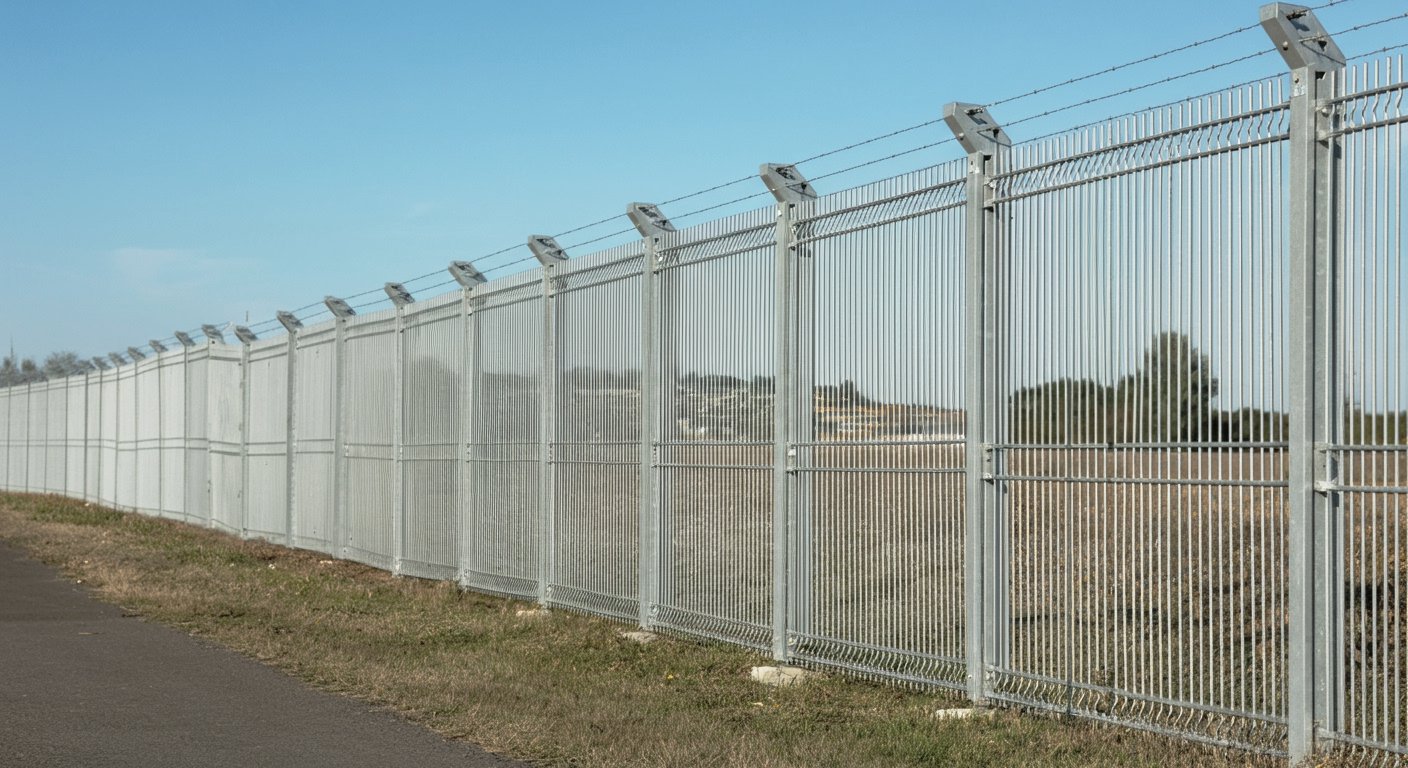Anti-climb fencing solutions are an effective way to secure your property and keep intruders out, giving you peace of mind. If you’ve been facing challenges with unwanted access, you're not alone. These solutions can help prevent safety risks, liability issues, and costly disruptions. But are they the right choice for your property? Here you will explore its key features and discover how to select the best option to meet your specific needs.
Key Takeaways:
- Purpose: These fences prevent unauthorized access with designs that block footholds and grips, offering security for properties, businesses, schools, and high-risk areas.
- Materials: Common options include steel (strong, durable) and aluminum (light, rust-resistant). Coatings like vinyl or galvanization protect against weather and wear.
- Design Features: Tight mesh, vertical bars, angled tops, and smooth surfaces deter climbing. Some designs also resist cutting and forced entry.
- Types: Options include welded wire (rigid, durable), wire mesh (tightly woven), expanded metal (cut-resistant), and perforated metal (light yet sturdy).
- Add-Ons: Fence spikes and spinning deterrents can enhance security but must comply with safety guidelines.
- Integration: Complements CCTV, alarms, and fence toppers for layered protection.
- Maintenance: Inspect fences quarterly for damage; low-maintenance options include galvanized or coated materials.
- Installation: Professional installation ensures proper setup for safety, durability, and adherence to local regulations.

Anti-climb Fencing Solutions
Anti-climb fencing solutions prevent unwanted access by using materials and designs that make climbing nearly impossible. For example, tightly spaced wires or smooth, tall surfaces eliminate footholds and grips. You’ll often see these fences around schools, businesses, and high-security areas. They effectively protect your property without appearing overly aggressive. Anti-climb fences reduce trespassing and property damage risks, providing reliable protection for you. Adding anti-climb measures fortifies boundaries, particularly in high-risk locations.
Some systems include features like sharp tips for added deterrence, making them suitable for areas requiring heightened security. Choosing the right design is key to addressing your security concerns while ensuring safety regulations are met.
Common Materials Used in Anti-Climb Fences
Anti-climb fencing solutions use durable materials like steel or high-grade aluminum. Steel offers excellent strength and resistance to tampering, making it ideal for high security fencing, while aluminum provides a lighter, rust-resistant option that ensures long-term durability. Some anti-climb fences feature specialized mesh or welded wire made from these metals, increasing their toughness.
Vinyl coatings or galvanized finishes protect your fence from weathering and wear, ensuring longevity and reducing the risk of structural weakening. The right material for your anti-climb fencing solution depends on your property’s specific needs, whether you're facing harsh environmental conditions or requiring heavy-duty security.
Design Features Prevent Climbing
Anti-climb fences use smart design elements to deter potential climbers. Tight mesh or vertical bars with narrow gaps are common, leaving no space for handholds or footholds. Welded wire panels, for example, offer an effective barrier for preventing climbing.
Angled tops that tilt outward are another feature to watch for, as they make scaling the fence particularly difficult. Smooth surfaces also eliminate grip points, further hindering intrusion attempts. These design components work together to stop climbing without requiring aggressive reinforcement.
Anti-Climb Fencing Solutions are Penetration Resistant
Anti-climb fencing solutions are designed to withstand cutting tools and other methods of forced entry. Strong materials like steel and aluminum resist bolt cutters, saws, and similar tools. Welded wire or steel panels are particularly valued for their security features, making them ideal for protecting your property.
By combining anti-climb and penetration-resistant features, you create a solid physical barrier for your property, business, or high-security zone. Selecting the right combination of material and design ensures a comprehensive and long-lasting security solution for your property.
Types of Anti-Climb Fencing Solutions
Welded Wire and Wire Mesh Designs
- Welded wire fences use intersecting wires fused at each point, creating a strong, rigid structure. This design excels in strength and durability, making climbing nearly impossible. Wire mesh designs feature tightly woven patterns with small gaps, making them difficult to grab or cut. Both options are effective metal anti-climb fences, but welded wire offers greater strength for high-security applications.
Expanded Metal and Perforated Metal Infills
- Expanded metal forms when a solid metal sheet is cut and stretched into a mesh-like pattern. This panel is strong, cut-resistant, and has no open edges. Perforated metal, made by punching holes into metal sheets, is lighter but still sturdy. Both types effectively deter climbing, though expanded metal offers greater resistance to force. These designs often serve as infills, providing added deterrence in commercial or industrial settings.
Fence Spikes and Spinning Deterrents
- Fence spikes attach to the top of fences to discourage climbing by making it uncomfortable or risky. Spinning deterrents, such as bars or cylinders that rotate freely, increase difficulty by preventing a firm grip. Both options effectively enhance security and deter climbing in high-risk areas.
For public spaces, consider legal and safety regulations before installation. Some jurisdictions restrict the use of certain features, like sharp implements, to minimize accidental harm. Resources like the National Security Guidelines can help you stay informed.
Choosing the Right Anti-Climb Fencing Solution
Start by defining what you want your anti-climb fencing solutions to do. The right fence depends on your goals. For example, a banking property may need different features than a warehouse or school.
Consider local risks and the environment. Urban areas may need stronger deterrents, while rural properties might focus on keeping out wildlife. Understanding these factors helps you choose the best anti-climb fencing solution for your needs.
Materials are also important. Steel is very durable, while coated designs fit better for more urban areas. Choose what works best for your security needs and visual preferences.
Balancing Budget, Design, and Security
Finding the right balance means prioritizing your needs. If safety is paramount, invest in quality high security fencing rather than cutting costs. Decorative steel designs may suit urban or office spaces, while simpler options could suffice for industrial areas.
Additionally, factor in long-term value. High-quality materials may cost more initially but often result in greater savings due to reduced repair and maintenance needs.
Anti-Climb Fencing Solutions with Security Measures
Pairing anti-climb fences with tools like CCTV or alarms creates a multi-layer system. Cameras provide constant visual monitoring, while alarms trigger immediate alerts. Together, this combination addresses vulnerabilities effectively.
Fence toppers such as barbed wire enhance perimeter security by further deterring climbers. When used alongside cameras and sensors, they form a comprehensive defense system that minimizes risks. For guidance on integrating these measures, refer to this guide.
Maintenance for Anti-Climb Fencing Solutions
Check your fence regularly to keep it secure. Inspect it every three months for issues like broken wires, bent sections, or loose posts. After storms or strong winds, check the fence right away. Regular checks allow you to fix problems quickly and avoid expensive repairs later.
There are low-maintenance fencing options. Fences made from galvanized or coated materials need little upkeep. These finishes protect against rust and corrosion, helping the fence last longer. While no fence is fully maintenance-free, durable materials reduce repair time and cost.
Installing Anti-Climb Fences Solutions
To install anti-climb fences effectively, it’s important to work with professionals. They ensure the fence is secure, properly placed, and meets local codes. Experts also have a deep understanding of materials and designs, which enhances the fence's effectiveness and lifespan. To find qualified installers, start by researching reputable companies and checking their credentials. Additionally, look for local contractors who have experience with anti-climb fencing. Be sure to confirm their licensing, read customer reviews, and ask for references. By working with skilled professionals, you can ensure proper installation and long-lasting results.
Anti-climb fences are reliable security solutions, crafted from strong materials and designed for maximum effectiveness. By considering your specific needs, balancing cost and design, and incorporating extra security features, you can build a robust defense system for your property. Furthermore, regular inspections and professional installation will help ensure your fence remains effective and lasts for years to come.
Protect Your Property with Anti-Climb Fencing Solutions!
Our expert team is ready to help you choose and install the ideal security fence tailored to your needs. With durable materials and advanced deterrents, we provide long-lasting protection for property, businesses, and high-security areas. Don’t compromise on safety—contact us today at United Fence Company to get started!


Leave a Reply